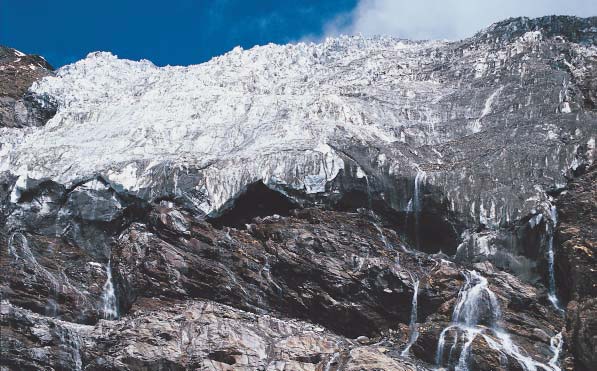 The MoEF discussion paper on Himalayan glaciers studies the phenomenon of glaciations and glacier dynamics, a phenomenon that has attained significant attention in recent years, on account of the general belief that global warming and climate change is leading to fast degeneration of glaciers in the Himalayas. It is argued that this would, in the long run, have an adverse effect on the environment, climate and the water.
The MoEF discussion paper on Himalayan glaciers studies the phenomenon of glaciations and glacier dynamics, a phenomenon that has attained significant attention in recent years, on account of the general belief that global warming and climate change is leading to fast degeneration of glaciers in the Himalayas. It is argued that this would, in the long run, have an adverse effect on the environment, climate and the water.
Glacial monitoring suggests that the average annual retreat was around 5m, although a few glaciers were observed to have higher retreat, such as the Pindari glacier in the Central Himalayas which was observed to have an annual retreat of 8-10m. Studies also revealed that fluctuation of the glacier snout is not a simple phenomenon that can be attributed to climate change, but in fact is the result of complex regional and local phenomenon.
The studies undertaken from mid 1970s till date have revealed the following interesting findings related to the glaciers in the Indian Himalayas:
- All the glaciers under observation, during the last three decades of 20th century have
 shown cumulative negative mass balance. Irrespective of latitudinal differences, glacier melt contributes to about 25 per cent to 30 per cent of the total discharge of glacier ice. Maximum discharge takes place from mid-July to mid-August.
shown cumulative negative mass balance. Irrespective of latitudinal differences, glacier melt contributes to about 25 per cent to 30 per cent of the total discharge of glacier ice. Maximum discharge takes place from mid-July to mid-August. - On an average, the sediment load producing capacity of glacier ice in the Himalayas has been found to be to the order of 30 tonnes of ice per day per square km² during the melt season in a granite / gneissic terrain.
- Ice, forming a glacier in the Himalayas, in its vertical profile, can exhibit the characteristics of a cold glacier at certain levels and that of a temperate glacier at other levels.
- Smaller glaciers in the Himalayas - less than 5km long - exhibit an ice thickness of the order of 250m in the cirque region, and an ice thickness of the order of 40-60m along the middle regions, though some larger glaciers like Zemu exhibit an ice thickness of over 200m in the middle regions.
- An aerosol/ dust cover of 400gm/m2 – a thickness of about 2mm - has the maximum effect as far as melting of glaciers is concerned. This impact is maximum on north facing glaciers in the month of September. Additional thickness of dust up to 4mm does not make any appreciable change in melting. In fact thickness of dust beyond 6mm serves more as an insulator rather than a conductor of solar heat.
- Himalayan glaciers, although shrinking in volume and constantly showing a retreating front, have not in any way exhibited, especially in recent years, an abnormal annual retreat, of the order that some glaciers in Alaska and Greenland are reported.
- Glaciers in the Himalayas, over a period of the last 100 years, behave in contrasting ways. As an example, Sonapani glacier has retreated by about 500m during the last one hundred years. On the other hand, Kangriz glacier has practically not retreated even an inch in the same period.
- It is premature to make a statement that glaciers in the Himalayas are retreating abnormally because of the global warming. A glacier is affected by a range of physical features and a complex interplay of climatic factors. It is therefore unlikely that the snout movement of any glacier can be claimed to be a result of periodic climate variation until many centuries of observations become available. While glacier movements are primarily due to climate and snowfall, snout movements appear to be peculiar to each particular glacier.
Download the paper here -
/articles/himalayan-glaciers-state-art-review-glacial-studies-glacial-retreat-and-climate-change